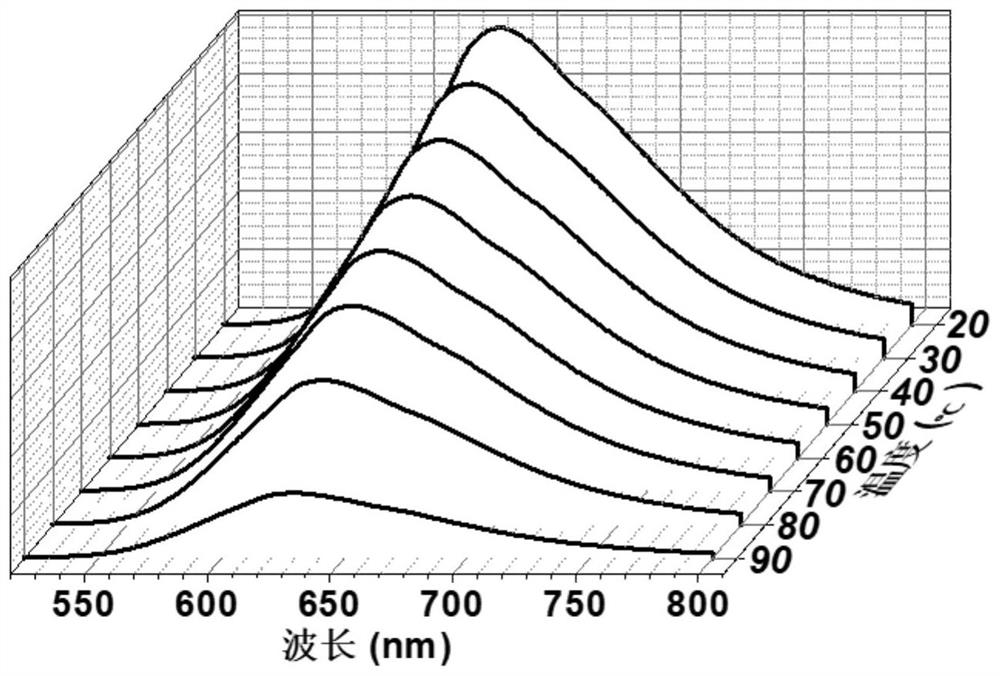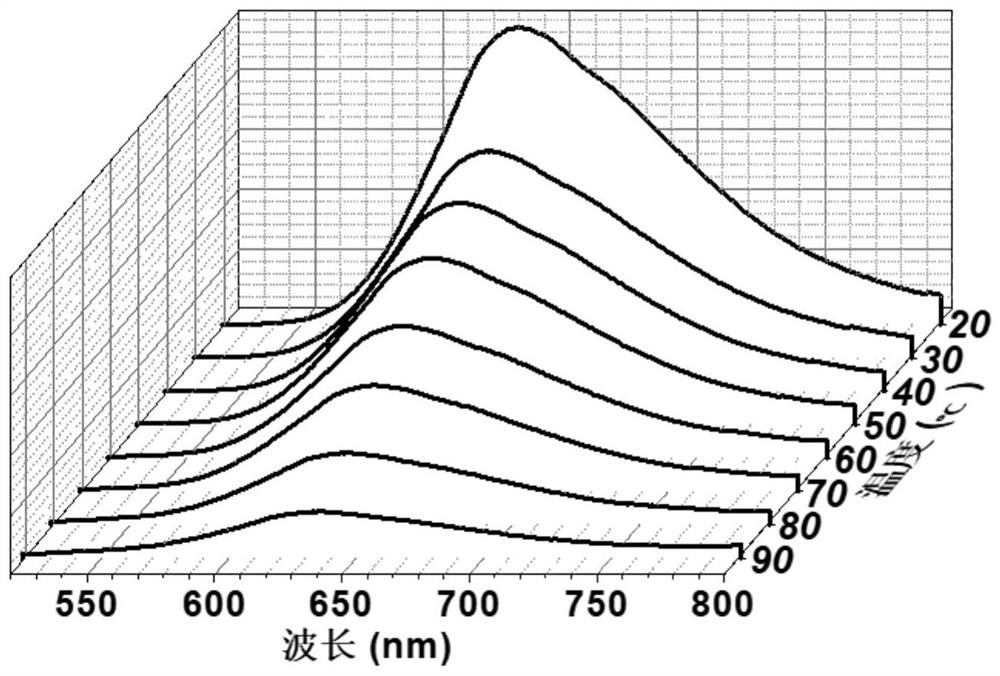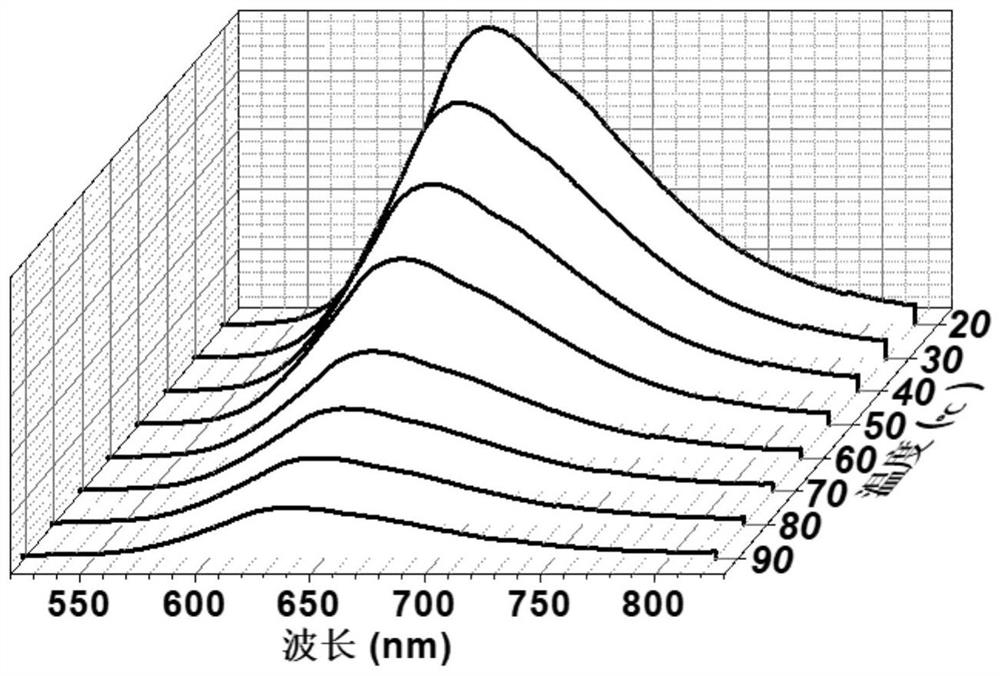Red light emitting material based on excited state proton transfer and preparation method and application thereof
A technology of proton transfer and luminescent materials, applied in luminescent materials, nanotechnology for materials and surface science, material excitation analysis, etc., can solve the problems of complex manufacturing process, high cost, poor stability, etc., and achieve high decomposition temperature, High thermal sensitivity and good thermal stability
- Summary
- Abstract
- Description
- Claims
- Application Information
AI Technical Summary
Problems solved by technology
Method used
Image
Examples
preparation example Construction
[0047] The preparation method based on the excited state proton transfer red light material comprises the following steps:
[0048] The first step: take intermediate 3-(benzo[d]thiazol-2-yl)-2-hydroxy-5-methyl-benzaldehyde (HBT-CHO) (0.50g, 1.86mmol) and intermediate 2, 2-Difluoro-4-methyl-6-phenyl-2(1H)-dioxaborane (DMBF 2 ) (0.47g, 2.23mmol) was mixed and added into a 100mL three-necked round-bottomed flask, and a double-row pipe was used to evacuate, blow nitrogen three times, and insert a nitrogen ball;
[0049] The second step: use a syringe to add piperidine (0.16g, 1.86mmol) under nitrogen environment, then add 40mL solvent absolute ethanol with a syringe; Bubble nitrogen for 30 minutes, put the reaction device into the oil bath, and the liquid level in the bottle Slightly higher than the liquid level of the oil bath, heating and refluxing for 12 hours;
[0050] The third step: after the reaction is completed, cool to room temperature, use a rotary evaporator to spin ...
Embodiment 1
[0054] A preparation method for preparing nanoparticles based on excited state proton transfer red light material in an aqueous solution or a PBS solution, specifically comprising the following steps:
[0055] The first step: transfer 1 mg of HBT-BF based on the excited state proton transfer red light material 2 Dissolve in 1mL THF to make a 1mg / mL solution;
[0056] The second step: under 1440W ultrasonic conditions, inject 1 mL of the solution into 10 mL of deionized water or PBS solution, and remove the tetrahydrofuran in the mixed solution by bubbling nitrogen;
[0057] The third step: heating and concentrating the prepared solution under a nitrogen atmosphere at 90 °C, and then filtering with a 0.2 μm filter; HBT-BF can be obtained 2 Nanoparticles in water or PBS solution.
Embodiment 2
[0059] A red light material based on excited state proton transfer and a non-energy transfer temperature-resistant diphenyl(6-(pyrrolidin-1-yl)pyrene-1-yl)phosphine oxide doped in PBS solution was prepared. The preparation method of nanoparticle specifically comprises the following steps:
[0060] Step 1: Weigh the excited state proton transfer red light material HBT-BF 2 Dissolve 1 mg of diphenyl(6-(pyrrolidin-1-yl)pyrene-1-yl)phosphine oxide and temperature-resistant fluorescent material diphenyl(6-(pyrrolidin-1-yl)pyrene-1-yl)phosphine oxide in 1 mL of THF respectively to make a 1 mg / mL solution;
[0061] The second step: proportioning the two solutions prepared by mass fractions of diphenyl (6-(pyrrolidin-1-yl)pyrene-1-yl)phosphine oxide: HBT-BF 2 = 1:3 ratio mixing, with 1440W ultrasonic mixing;
[0062] The third step: under 1440W ultrasonic conditions, inject 1mL of the mixed solution into 10mL of deionized water or PBS solution, and remove the tetrahydrofuran in the ...
PUM
 Login to View More
Login to View More Abstract
Description
Claims
Application Information
 Login to View More
Login to View More - R&D
- Intellectual Property
- Life Sciences
- Materials
- Tech Scout
- Unparalleled Data Quality
- Higher Quality Content
- 60% Fewer Hallucinations
Browse by: Latest US Patents, China's latest patents, Technical Efficacy Thesaurus, Application Domain, Technology Topic, Popular Technical Reports.
© 2025 PatSnap. All rights reserved.Legal|Privacy policy|Modern Slavery Act Transparency Statement|Sitemap|About US| Contact US: help@patsnap.com



